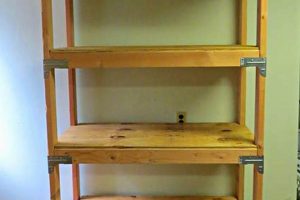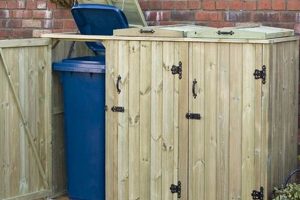Effective organization within a residential garage often involves the creation of customized solutions. These solutions are typically designed and implemented by the homeowner to maximize available space and accommodate specific storage requirements. The assembly and installation can be undertaken without professional assistance, utilizing readily available materials and tools. For instance, a homeowner might construct shelving units from lumber or install prefabricated racking systems to house seasonal items or tools.
The advantages of these personalized organizational strategies are multifaceted. They offer a cost-effective alternative to commercially available storage solutions, empowering homeowners to tailor the design to their precise needs and spatial constraints. Historically, resourceful individuals have always adapted their environments to improve functionality, and garage organization is a modern extension of this practice. The result is a more efficient and less cluttered garage environment, contributing to improved home organization and overall property value.
The subsequent discussion will examine various approaches to efficient garage space management, exploring different design considerations, material selection, and installation techniques. The goal is to provide a foundational understanding to enable informed decision-making for optimizing garage storage capabilities.
Optimizing Garage Organization
The following recommendations aim to guide the efficient implementation of personalized organizational solutions in residential garages. These strategies focus on maximizing space utilization, enhancing accessibility, and ensuring the secure storage of items.
Tip 1: Vertical Space Maximization: Utilize wall-mounted shelving units and overhead racks to capitalize on unused vertical space. This approach frees up floor area and provides storage for less frequently accessed items. Example: Store seasonal decorations in labeled bins on high shelves.
Tip 2: Implement a Categorization System: Group similar items together to facilitate easy retrieval and prevent clutter. Designate specific zones for tools, sporting equipment, automotive supplies, and gardening materials. Example: Create a tool wall with clearly labeled hooks and organizers.
Tip 3: Employ Transparent Storage Containers: Opt for clear plastic bins or containers to allow for quick identification of contents without the need to open each one. This saves time and reduces the likelihood of misplacing items. Example: Store hardware items in transparent containers with labeled lids.
Tip 4: Utilize Pegboards for Tool Storage: Install a pegboard on a garage wall to organize hand tools and other frequently used items. Pegboards provide flexibility and allow for easy rearrangement of tools as needed. Example: Hang wrenches, screwdrivers, and pliers on a pegboard near a workbench.
Tip 5: Optimize Corner Spaces: Employ corner shelving units or custom-built corner cabinets to utilize often-overlooked corner spaces. This maximizes storage capacity and prevents wasted space. Example: Store paint cans and cleaning supplies in a corner cabinet.
Tip 6: Incorporate a Workbench Area: Designate a specific area for a workbench, complete with adequate lighting and storage for tools and materials. This provides a dedicated space for projects and repairs. Example: Install a sturdy workbench with drawers and cabinets for tool storage.
Tip 7: Regular Decluttering and Maintenance: Establish a routine for regularly decluttering the garage and removing unwanted items. This prevents the accumulation of clutter and ensures that the organizational system remains effective. Example: Conduct a garage clean-out twice a year to remove unused items.
Adopting these strategies contributes to a more organized, functional, and accessible garage environment. The resulting space will promote efficiency and improve the overall utility of the garage.
The subsequent section will address common challenges encountered during the implementation process, offering practical solutions to overcome these obstacles.
1. Spatial Analysis
Spatial analysis forms the foundational stage in the successful implementation of personalized garage organization solutions. A comprehensive understanding of the available space and its inherent constraints is paramount to maximizing storage efficiency and utility.
- Measurement and Dimensioning
Accurate measurement of the garage’s length, width, and height is essential. Detailed dimensions, including door and window placements, electrical outlet locations, and any existing structural features, must be recorded. These measurements dictate the feasible scale and configuration of any planned storage infrastructure. Failure to accurately measure can result in ill-fitting or functionally compromised systems.
- Identification of Constraints
Spatial analysis must identify any physical limitations within the garage environment. These constraints can include low ceilings, protruding pipes, uneven floors, or limited wall space. Recognizing these limitations early allows for proactive adaptation in the design phase, preventing costly modifications or design failures during implementation. For instance, low ceilings might necessitate horizontal storage solutions rather than vertical shelving.
- Assessment of Traffic Flow
The analysis should account for the typical movement patterns within the garage. Designated pathways for vehicles and pedestrians should be maintained to ensure safety and ease of access. Storage solutions should be positioned to minimize obstruction of these pathways and maintain clear lines of sight. Impediments to traffic flow can compromise safety and reduce the usability of the garage.
- Evaluation of Item Inventory
A thorough inventory of items intended for storage within the garage is necessary. This inventory should categorize items by size, weight, and frequency of use. Understanding the spatial requirements of these items informs the selection of appropriate storage solutions and ensures that the system is tailored to the specific needs of the homeowner. For example, storing large sporting equipment requires larger, more accessible storage spaces than storing small tools.
These elements collectively establish a detailed understanding of the garage’s spatial characteristics. This understanding directly informs the design and construction of personalized garage storage systems, optimizing space utilization and ensuring functionality. Proper spatial analysis promotes efficient organization, easy access, and a safe, uncluttered garage environment.
2. Material Selection
Material selection is a critical determinant in the efficacy and longevity of any “diy garage storage systems”. The garage environment presents unique challenges, including fluctuating temperatures, potential moisture exposure, and the need to support substantial weight. Consequently, the materials chosen must be robust and appropriate for these conditions.
- Wood: Strength and Treatment
Wood, particularly lumber like plywood or dimensional lumber, is a common choice due to its relative affordability and ease of workability. However, untreated wood is susceptible to moisture damage and insect infestation. Therefore, proper treatment with sealants, preservatives, or paint is essential to enhance its durability in the garage environment. Examples include constructing shelving units from pressure-treated lumber or applying a moisture-resistant coating to plywood surfaces. Untreated wood in a damp garage setting can lead to structural failure over time.
- Metal: Durability and Corrosion Resistance
Metal, such as steel or aluminum, offers superior strength and resistance to heavy loads. Steel is commonly used for shelving frames and support structures. However, steel is prone to corrosion, necessitating protective coatings like powder coating or galvanization. Aluminum, while more expensive, offers inherent corrosion resistance. An example is using powder-coated steel for a heavy-duty racking system to store automotive parts. Without adequate corrosion protection, metal components can degrade, compromising the system’s integrity.
- Plastics: Versatility and Moisture Resistance
Various plastics, including high-density polyethylene (HDPE) and polypropylene, provide moisture resistance and versatility. Plastic bins, containers, and shelving components are frequently used for storing items that might be susceptible to moisture damage. While plastics are generally resistant to corrosion, they may lack the strength of wood or metal for supporting heavy loads. Storing gardening supplies in plastic bins to prevent water damage is a practical example. However, relying solely on plastic shelving for heavy tools might result in structural failure.
- Composites: Balancing Strength and Durability
Composite materials, such as wood-plastic composites (WPC), offer a balance of strength, durability, and moisture resistance. WPC can be used for shelving or work surfaces, providing a more durable alternative to traditional wood while mitigating the risk of moisture damage. These materials are often more expensive but can extend the lifespan of the storage system. Implementing WPC for workbench surfaces ensures longevity in a garage environment prone to spills and moisture. Conversely, opting for cheaper, less durable materials may necessitate frequent repairs or replacements.
The successful “diy garage storage systems” hinges on informed material selection. Each material possesses unique characteristics that must be carefully considered in relation to the specific demands of the garage environment and the intended load-bearing requirements. Balancing cost considerations with the need for durability and longevity is essential for creating a functional and sustainable storage solution.
3. Structural Integrity
Structural integrity is paramount to the safety and functionality of self-assembled garage storage infrastructure. Ensuring that these systems can withstand the intended loads and environmental conditions is critical to prevent failures that could result in property damage or personal injury.
- Load-Bearing Capacity and Weight Distribution
The primary concern is the ability of the storage system to support the anticipated weight. This requires accurate calculation of the maximum load the system will bear, considering both static loads (constant weight) and dynamic loads (weight from moving or shifting items). Weight distribution must be even to prevent stress concentrations that can lead to component failure. For example, a shelf designed to hold 100 pounds may collapse if that weight is concentrated in one area. In “diy garage storage systems”, understanding weight distribution principles is crucial for safe design and construction.
- Material Strength and Fastener Selection
The choice of materials directly impacts the structural integrity of the system. Materials must possess sufficient strength to withstand the applied loads without excessive deformation or fracture. Similarly, fasteners (screws, bolts, nails) must be appropriately sized and spaced to securely connect the components. Using undersized screws in a heavy-duty shelving unit, for instance, can lead to joint failure and collapse. Selection of materials and fasteners is a direct and vital component for any design considerations for “diy garage storage systems”.
- Joint Stability and Bracing Techniques
The manner in which the components of the storage system are joined significantly affects its overall stability. Joints must be strong and rigid to prevent racking or swaying. Bracing techniques, such as diagonal supports or gussets, can be employed to reinforce joints and increase resistance to lateral forces. A poorly constructed joint in a workbench leg, for example, can cause the entire structure to become unstable. Stability and bracing can improve quality and reduce costs of “diy garage storage systems”.
- Environmental Resistance and Material Degradation
Garage environments can expose storage systems to temperature fluctuations, humidity, and potential chemical exposure. The materials used must be resistant to these environmental factors to prevent degradation over time. Wood, for example, can warp or rot in humid conditions if not properly treated. Metal can corrode if exposed to moisture. Incorporating weather resistance materials can extend lifetime use for “diy garage storage systems”.
These considerations underscore the importance of careful planning and execution in “diy garage storage systems”. Ignoring these factors can compromise the structural integrity of the system and create hazardous conditions within the garage. Proper attention to load-bearing capacity, material strength, joint stability, and environmental resistance is essential for ensuring the long-term safety and functionality of any DIY storage solution.
4. Customization Options
The adaptability of “diy garage storage systems” stems directly from the breadth of available customization options. These options empower individuals to create solutions tailored to their specific needs, spatial constraints, and budgetary considerations, moving beyond the limitations of pre-fabricated storage units.
- Adjustable Shelving Systems
Adjustable shelving allows for flexible configuration to accommodate items of varying sizes. Shelf height can be modified to maximize vertical space and efficiently store items ranging from small tools to large bins. This adaptability is particularly useful in garages where storage needs may evolve over time. For example, shelves can be spaced closer together for storing hand tools and supplies, or spaced further apart for storing large automotive parts. Without this flexibility, space can be wasted, or certain items may not fit within the storage system.
- Specialized Racking and Hooks
Specialized racking and hooks are designed to store specific items, such as bicycles, sports equipment, or gardening tools. These solutions provide dedicated storage spaces, preventing clutter and ensuring that items are readily accessible. A bicycle rack, for instance, can free up valuable floor space and protect bicycles from damage. Similarly, hooks can be used to hang tools, hoses, or extension cords, keeping them organized and within easy reach. Lack of such specialized storage solutions often leads to items being piled on the floor or leaned against walls, creating a disorganized and potentially hazardous environment.
- Custom Workbench Designs
A custom-designed workbench provides a dedicated workspace tailored to the specific needs of the user. The workbench can be equipped with drawers, cabinets, and other storage compartments to keep tools and materials organized and within easy reach. The size and layout of the workbench can be customized to suit the available space and the types of projects typically undertaken in the garage. For example, a woodworker may require a larger workbench with built-in storage for saws, chisels, and other woodworking tools. Conversely, a mechanic may prefer a smaller workbench with storage for wrenches, sockets, and other automotive tools. Absence of a customized workbench often results in working on makeshift surfaces, leading to inefficiency and potential damage to tools and materials.
- Mobile Storage Solutions
Mobile storage solutions, such as rolling carts or cabinets, provide flexibility and portability within the garage. These solutions can be easily moved to different locations as needed, allowing for efficient use of space and easy access to tools and materials. A rolling tool cart, for instance, can be moved to the area where work is being performed, eliminating the need to repeatedly walk back and forth to retrieve tools. Without mobile storage options, tools and materials may be scattered throughout the garage, making it difficult to find what is needed and slowing down work progress.
The inherent variability in garage dimensions and storage requirements underscores the importance of these customization options. The ability to adapt and tailor solutions ensures that “diy garage storage systems” effectively address individual needs, optimizing space utilization and promoting a well-organized and functional garage environment.
5. Accessibility Design
Accessibility design, when applied to DIY garage storage solutions, transcends mere convenience and becomes a critical factor in ensuring usability and safety for all users. Effective garage organization should facilitate ease of access to stored items, regardless of physical capabilities, age, or stature. The integration of accessibility principles enhances the functionality of these systems, transforming them from potential obstacles into assets that improve daily life.
- Reach and Placement Considerations
The positioning of storage units and the height of shelving directly impact accessibility. Items should be stored within a comfortable reach zone for all users, minimizing the need for excessive bending, stretching, or climbing. Frequently used items should be placed at waist height, while less frequently accessed items can be stored higher or lower. For example, storing heavy tools on high shelves presents a significant safety hazard, particularly for older individuals or those with limited mobility. A design that prioritizes ergonomic placement significantly reduces the risk of strain and injury.
- Clear Pathways and Maneuvering Space
Garage storage systems should not impede movement within the space. Adequate pathways must be maintained to allow for easy passage, even when carrying items. Sufficient turning space should be provided for individuals using mobility aids, such as wheelchairs or walkers. Cluttered pathways and restricted maneuvering space pose a significant safety risk, increasing the likelihood of trips and falls. Proper spatial planning ensures that the garage remains a safe and functional environment for all users.
- Visibility and Identification
Clearly labeled storage containers and well-lit storage areas enhance accessibility by facilitating quick identification of items. Labels should be large, legible, and placed in a consistent location on each container. Adequate lighting is essential to ensure that labels and items are easily visible, even in dimly lit corners of the garage. Difficulty in identifying stored items leads to frustration and wasted time. Clear labeling and sufficient lighting are simple yet effective measures that significantly improve accessibility.
- Assistive Devices and Adaptive Solutions
The integration of assistive devices, such as step stools with handrails or grabber tools, can further enhance accessibility for individuals with physical limitations. Adaptive solutions, such as adjustable-height workbenches or pull-down shelving systems, can be customized to meet specific needs. Incorporating these features demonstrates a commitment to inclusivity and ensures that the garage remains a functional and accessible space for all members of the household. Failure to consider these needs can lead to exclusion and limit the usability of the garage for certain individuals.
In conclusion, accessibility design is an integral component of effective DIY garage storage solutions. By considering reach, pathways, visibility, and assistive devices, homeowners can create garage environments that are safe, functional, and inclusive. The benefits extend beyond mere convenience, contributing to the overall well-being and independence of all users.
Frequently Asked Questions
This section addresses common inquiries regarding the planning, construction, and implementation of personalized garage organizational infrastructure. The aim is to provide concise and informative responses to assist in the informed decision-making process.
Question 1: What is the optimal method for assessing the structural integrity of self-constructed shelving?
The structural integrity is evaluated through load testing. The shelving unit should withstand a load exceeding the anticipated maximum weight by a safety margin. Regular inspections for signs of stress, such as bowing or joint separation, are recommended.
Question 2: Which factors should be considered when selecting materials for garage storage solutions in humid climates?
Material selection must prioritize moisture resistance. Pressure-treated lumber, composite materials, or powder-coated metals are suitable options. Adequate ventilation within the garage is also recommended to mitigate humidity levels.
Question 3: How can existing garage space be maximized when implementing organizational systems?
Vertical space utilization is key. Wall-mounted shelving, overhead racks, and pegboard systems can effectively expand storage capacity without encroaching on floor space. A thorough inventory and spatial analysis will inform optimal placement.
Question 4: What are the implications of failing to secure storage systems to the garage walls or floor?
Unsecured storage systems pose a significant safety hazard. They are susceptible to tipping, particularly when loaded unevenly, potentially causing property damage or personal injury. Anchoring to structural elements of the garage is essential.
Question 5: What steps should be taken to mitigate the risk of pest infestation within garage storage systems?
Employ pest-resistant materials such as metal or sealed plastic. Store items in airtight containers. Regularly inspect the garage for signs of pests and implement appropriate control measures. Avoid storing food items or organic materials that may attract pests.
Question 6: How frequently should garage storage systems be inspected and maintained?
A visual inspection should be conducted at least twice annually. Inspect for signs of damage, such as corrosion, rot, or joint failure. Fasteners should be tightened as needed. Promptly address any identified issues to prevent further degradation.
In summary, prioritizing structural integrity, material selection, spatial efficiency, safety protocols, and regular maintenance are critical for the successful and sustained functionality of garage organization strategies.
The following section will delve into real-world examples of successful garage organization implementations, highlighting best practices and innovative solutions.
Conclusion
The preceding exploration has emphasized the critical factors in designing and implementing effective “diy garage storage systems.” From spatial analysis and material selection to structural integrity, customization options, and accessibility design, each element plays a crucial role in creating a functional and safe organizational infrastructure. Prioritizing these considerations ensures efficient space utilization, prevents potential hazards, and enhances the overall utility of the garage environment.
Ultimately, the success of such initiatives hinges on meticulous planning, diligent execution, and a commitment to regular maintenance. The principles outlined provide a foundation for homeowners to transform cluttered and inefficient garages into organized and valuable assets, thereby contributing to improved home management and property value. Continued innovation and adherence to best practices will further refine these systems, maximizing their potential for years to come.







